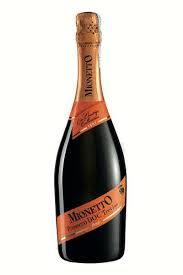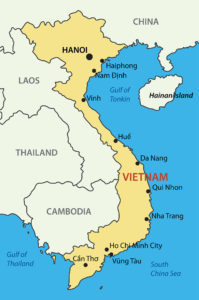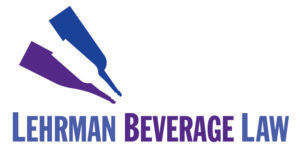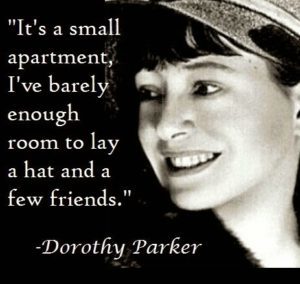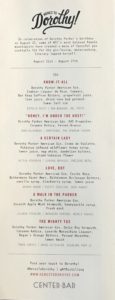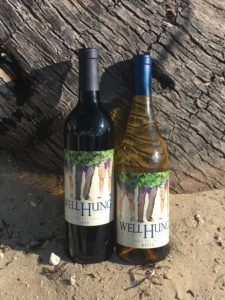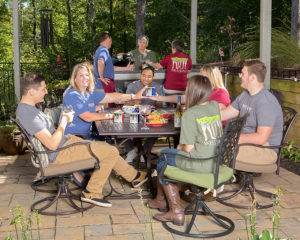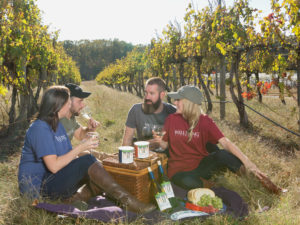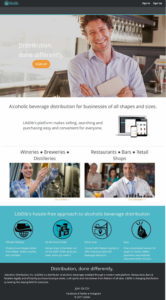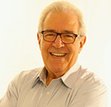Arthur Shapiro's Blog, page 5
December 20, 2017
The Missing Prosecco: A New York City Story
The City of New York has a building ordinance called Local Law 11, described as follows:
To keep buildings safe, owners of properties higher than six stories must have exterior walls and appurtenances, such as balconies, inspected every five (5) years – and they must file a technical façade report with the Department.
Recently, the building in which I live was inspected by our engineering firm and it was determined that we needed to inspect the building—particularly the balconies—and that repair work needed to take place.
So, starting in July, a pedestrian bridge (also known as a shed) went up all around the sidewalk of our building, scaffolding was deployed, and a team of workers began to prepare the façade and mainly the balconies. It’s a complicated process so I’ll spare you the details. It’s sufficient to say that we could not use our small balcony in the summer or fall and it took until mid-December for the work to be completed.
Despite the slight inconvenience, I was in awe of the men riding the scaffold each day to do the job. Imagine going up and down a 31-floor building, doing this for more than eight hours a day, and getting on and off to work on balconies. I get dizzy and wobbly getting on a step ladder to change a bulb. There is not enough money for me to even contemplate getting on a scaffold—including what Diageo paid for Casamigoes.
Now on to the story…
One day last week, our balcony was finished and I opened the door, partly because I wanted a close look at the work (fabulous) and mainly because I could, for the first time in six months. I didn’t stay there long; it was freezing out.
It just so happens that on that particular day we had a small group of friends coming over for a cocktail party. I bought what I needed from the nearby wine and spirits shop—hey, it’s NYC and there’s one every other street. Included in my order was four bottles of prosecco… Mionetto Prosecco to be exact. Sparkling wine is fun, celebratory, easy to serve, and some folks prefer it to other drinks.
My order arrived but the problem was how to keep the prosecco cold; the refrigerator was full of food and I could only get two bottles in. How to keep the other two bottles cold was a bit of a dilemma.
I know, I thought, now that the balcony was accessible, I’ll do what most of my neighbors and I do in the winter and store two bottles out there. If you live in an apartment in the city, you don’t have room for an extra refrigerator, so a balcony, or even a fire escape, when the temperature is low enough, will do the trick.
Two bottles in a plain black plastic bag were put outside to keep cold. But different types of alcohol freeze differently. An 80 proof (40%AbV) spirit will not freeze but a wine at 8 to 14% AbV will first turn to slush then freeze after just an hour or two. I had visions of frozen sparkling wine and shooting corks taking out neighbors’ windows.
So, around fifteen minutes before our guests were due to arrive, I went out to the balcony to check on my cache.
The balcony was empty.
No booze. Gone. Disappeared.
I live on the 11th floor of the building so, unless Spider Man was in the upper east side and decided to climb up to my balcony and take the prosecco, there was only one other explanation—the workers took it.
I called the building superintendent, a good friend, and laughingly told him the situation. He immediately deduced that they were on a scaffold going down and finished for the day, so they must have thought the wine was a gift for them. Hmmm. Made sense to me. “Never mind,” I said. “Let them enjoy it.” His reply was a terse, “Let me see what I can do.”
I shrugged and immediately called the liquor store and, reminding them what a good customer I am, I begged them to send up two more bottles asap.
Ten minutes later the doorbell rang. Two gentlemen were standing outside. One was the delivery guy from the store and the other was one of the building employees. Each had a bag containing two bottles of prosecco. We now had six.
The aftermath
I felt really badly about the building taking the assumed gift away from the workers. These fellows worked long and hard and a couple of bottles of booze was small additional compensation. But my friend the super thought he was doing me a favor. I shouldn’t have called him.
What really pissed me off was that of the six bottles of prosecco, only one was consumed. A couple bottles of Eagle Rare Bourbon, seemed to be the preferred libation.
As we say in New Yawk, go figure.
 My building
My building
November 9, 2017
Ted’s Vietnam Adventure—Part Two
Our story so far: Ted McDonnell, a salesman and brand builder working in Asia, has been given the assignment to work with the Chivas Regal group. He is sent to Vietnam to help the local team grow the brand in the newly opened market. Unfortunately, and unbeknownst to Ted, he ends up in Hanoi when he was supposed to go to Ho Chi Minh City (formerly Saigon). By the time Ted learns of his mistake, he has been through a bit of an ordeal—deserted, dark and lonely roads, fears of having been kidnapped, going from hotel to hotel in search of a place to stay, and exhaustion from the ordeal.
But, Ted also learns that the Vietnamese he meets are warm and friendly and, despite his fears, are anxious to help him.
We pick up our story at the point where Ted has just learned of his mistake. (Here is part one.)
Back to the Airport
So, it’s late, Ted is exhausted and anxious to get to Ho Chi Minh City. If he stays in Hanoi—assuming he can find a hotel room this late at night—he will lose time in getting there. Then the thought hits him: Get back to the airport, surely there’s a hotel there, and get the first plane out to the southern city.
Ah, but what about money? Credit cards are not yet widely accepted and he has a limited amount of dollars (having paid Tran, the driver most of what he had), but he has over 300 British Pounds. “After all,” thinks Ted, “if a dollar can buy 17,000 Dong (Vietnamese currency) the pound should buy a billion. I should have enough.” Although, the universe may have other ideas.
But, first things first. He has to find a hotel at the airport and get a shower and some much-needed sleep. Then get up early, buy a plane ticket and get back on track.
Unfortunately, when he arrives back at the airport, he learns that that there are no hotels, in those days. What happens next according to Ted:
“There was no hotel just a building that was used for airport workers to sleep and they charge them so many Dong a night. I said, ‘Well that’s where I’m going to be sleeping but I need my own room.’ So, Tran wakes up the owner of the hotel at 1 o’clock in the morning. They’re screaming at each other, I’m saying, ‘I need a hotel room because I have to get the first plane.’ They’re thinking I’m crazy.”
“After a little haggling, I gave the last of my US dollars to the hotel guy. He was happy. I also gave Tran his money and he was happy. I got my room. They put my boxes and my luggage there with me and said, ‘Good night.’ I closed the door. I went to take a shower but there was no running water.”
One thing you can always say about a Seagram person, especially the folks who worked in Asia, no matter what, they’ll find a solution. In true form, Ted decides that if he can’t shower, he’ll use the sink. He turns on the faucet and out comes a lovely shade of brown water. He figures “what the hell,” finds a bucket fills it with the water and puts his head into it to cool down.
Please don’t laugh folks… desperate times call for desperate measures.
He’s feeling a bit better (or so he says) and puts on a clean t-shirt, turns out the lights, and quickly falls asleep. For about 15 minutes.
“Something was scratching and rattling the door. Well, you couldn’t believe how tired and exhausted I was, but I was still able to push the bed, the desk, the boxes, and my luggage up against the door. And I stared at that door for another half hour.”
The next day
Finally, around three o’clock in the morning, Ted falls asleep but is up at five to get to the airport, be the first on line to exchange money, get the ticket to Ho Chi Minh City, maybe even find a lounge (there was none) to wait for the plane. At seven, the foreign exchange opens and he’s first on line. He is starting to breathe a sigh of relief, reliving the ordeal of the night before and even managing to laugh about it. But not for long.
“We don’t take this,” the woman behind the counter says.
Ted is shocked: “This is pounds sterling… this is very important money, more valuable than US dollar.”
“No, we only take American dollar, Malaysian Ringett, also take Chinese money, but we don’t take this.”
Ted says, “You please take this, I need to get on a plane for the South and my flight’s at 7:30.” The reply is a firm No!
Ted leaves the counter and once again decides that desperate times call for desperate measures. He decides to approach people and beg.
He walks up to every person, and asks them if they have any money that they would be willing to exchange for pounds sterling. He tells them, “This is what I need to buy a ticket, can you help me?”
Two or three people just refused to speak English to him. One person gave him a few dollars and he thinks he ended up giving him twice the value in pounds because he was so desperate. A few more people gave him money. Finally, one person gave him $100 for 200£ (pounds). According to Ted, “That was a rip off but I was just so happy that I had enough money to buy a ticket.”
And, so, Ted at long last is going to the south. He, his luggage and what’s left of the trinkets, t-shirts and training material get on board. The door closes but Ted is already fast asleep.
 Ho Chi Minh City today
Ho Chi Minh City todayThe aftermath
If this story was fictional, such as one of my screenplays, Ted’s nightmare would continue (and perhaps get worse) when he landed in Ho Chi Minh City. If you were expecting that, dear reader, forget it. The universe figured he’d been through enough and decided to smile at him.
He arrives, goes easily through customs, meets his Seagram colleagues, who take one look at him and say, “Man, you need a drink, a bed, and a shower. Which do you want first?” They go on to say, “By the way, you have a training session in 3 hours and you need to be there.”
Ted is so thrilled he replies, “Of course I’ll be there.” He checks into his hotel, unpacks and sits in the shower for 30 minutes. All the while thinking about the people in that house, Tran, his friend, the policeman, the people that he met that night, and how everyone was so easy and nice to talk to.
The session with the Vietnam sales team was a big success with the attendees paying rapt attention, absorbing the information like sponges, and the excitement about Chivas Regal was palpable.
Let’s close with a final word from Ted McDonnell:
“I encourage everybody that I talk to, to go to Vietnam because the people are lovely and the country is lovely. Thank you for the opportunity to share my little salesman story. Every salesperson has a door he knocks on or a town he walks into cold turkey. Well, I walked into Vietnam cold turkey thinking all night I was in a city that I was not in at all.”
~~~~~~~~~~~~~~~~~~
Ted McDonnell now runs the Liberty Lighthouse Group, an international alcohol beverage sales and marketing agency. The company’s key objective is to support its Brand Companies to either establish new brands or to further support established brands throughout Asia/Pacific and other Global markets.
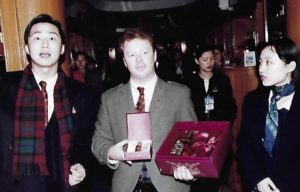 Ted at his training session in 1994
Ted at his training session in 1994
November 1, 2017
One Year Later
My book has been on the market for the past year and the feedback has been great. I just wanted to say thank you.
If you haven’t had a chance to buy it as yet, here is a direct link to Amazon and the book. You can also order it through Barnes and Noble here.
October 12, 2017
Vietnam and Chivas Regal: A Salesman’s Story
Ted McDonnell was a top-notch salesperson in the Asia-Pacific/Global Duty-Free division of Seagram Spirits and Wine Group. (SSWG or ‘swig’ as it was referred to.) Ted had spent his career living in Australia, Hong Kong, and Guam as a regional director fixing problems and building brands all over Asia-Pacific.
Then one day an outstanding opportunity came his way in the form of a job with Chivas Brothers. He no sooner got settled in London when he was told that among his first assignments was to go to Vietnam to do sales training on behalf of the brand. President Clinton opened the market to trade and management was anxious to expand opportunities in the emerging market.
His excitement was palpable and, as he waited for his visa, he gathered point of sale and training materials. As he scurried about making preparations—including attending a companywide meeting—he was not able to get his ticket and visa until the last minute. He ended up collecting five boxes of gifts and items that the sales and marketing people could use. You can imagine the effort he put in to get the right stuff and when the week’s wait was over, he ran to his office and collected the visa and plane tickets.
While hoping to stay awake on the flight to see the approach to the country, he instead fell asleep and awoke as the plane landed in a dark and ominous looking airport surrounded by what appeared to be machine gun towers. As he disembarked he felt a bit of relief, when a Vietnamese man tapped him on the shoulder and asked, “Are you an American?”
He quickly said, “Oh no I’m British, I’m here with Chivas Regal Whisky.” The man smiled and said, “Would you please tell your American friends we wish they would come back, we’ve missed them.”
With this surprising start to his journey, he collected the five boxes, breezed through customs, and left the terminal to find his colleagues who were to meet him.
Hello Vietnam
Two problems got his immediate attention. Here he is at the airport of Ho Chi Minh City (formerly Saigon) and it’s basically an open-air cement building—hardly what he expected from the biggest city in the country. Second, there were well over 200 people waiting to greet deplaning passengers but no one was there for him. He waited and worried.
“You need taxi? My name is Tran,” said the young man who approached him. “No, I’m waiting for my friends to pick me up,” was Ted’s reply.
A few hours passed while he stopped people to ask if they knew where the Seagram office was in the city. After a while, Ted noticed Tran hanging around the terminal again. He decided to approach him.
“Tran, bring your car, I think we will go to the city. My friends forgot about me.” So, Tran is very happy, and goes to get his car. As Ted describes it, “The car is a little more than a shoe box and I had a hard time squeezing in with the five boxes, my computer bag and the one piece of luggage I had with me.” But off they went.
Tran is very quiet as they drive along a very dark road without much lights. As they are crossing a bridge, Tran stops the car and says, “I go back and get my friend. I go back and get my friend.” Ted nervously replies, “no, no, no… I’m paying you to take me to the city.” To which Tran says, “Yeah, I know I take you to the city… but first I go back and get my friend.”
The next thing Ted knows, Tran turns the car around and heads back to the airport. Only this time the road is deserted and no cars are on the highway.
Ted starts to get very nervous
“How come there are no other cars… how come I’m the only one on the highway and there is the airport… it’s getting dark…only the lights are on out front of the airport with three men standing there and I’m thinking this is it for me. I’m getting kidnapped, you’re never going to see me again and there’s going to be a letter to my family of some sort… I’m thinking I’ve got to get out of the taxi when we reach the airport. But before I can get my hand on the door this guy jumps in the front seat and smiles and says, ‘Hello Joe. How are you Joe?’ I said, ‘Uh, uh, good’ and we’re driving back toward the bridge.”
Picture this—Ted is stuck in the back street, wedged in among the 5 boxes, computer bag and luggage while Tran and his friend are getting angry and arguing with each other. The friend suddenly reaches into the glove box, turns around and points two things at Ted, one in each hand. He can barely see what it is but is sure it looks like a gun. Ted thinks, “Why the hell did I put myself in this fix?”
After a second or two, Tran’s friend says, “Richard Marx or Air Supply cassette player?” Ted starts laughing and so does Tran and his friend. He puts on Richard Marx and he says, “You sing, you sing for us.” Ted’s thinking, “I don’t sing, but if I don’t I may end up in a ditch so sing your friggin’ heart out.”
Now they’re tooling down the muddy roads and all singing Richard Marx and Air Supply in a bizarre (yet frightening for Ted) karaoke event. After a while, they slow down next to a house, the friend gets out and tells Ted to do the same. Ted protests; Tran’s friend is most insistent and mutters something about needing gas to get to the city.
Ted reluctantly leaves the car and is standing on the side of a dark road with all his gear, dressed in a blazer, gray slacks and white shirt. His fear has just gone up a notch or two.
Ted recollects: “But there, next to the little house were three little kids and an old lady that comes out the front door. She takes my hand and leads me inside, sits me down on a small stool. Now that could only be a small stool because if I stood up I think my head would have gone through the roof.” It turns out to be Tran’s family.
What follows is Vietnamese hospitality as Ted is served tea and some food as he begins to relax a bit. He even starts playing with the children and making duck and animal sounds while he waits for Tran to return. All the while he’s thinking that this is the craziest kidnapping ever.
At long last Tran appears and announces, “Okay we go now.” Ted is relieved and delighted and can’t wait to get to Ho Chi Minh City, a shower, and a comfortable Marriott bed. Goodbyes, smiles and happiness is shared all around. In fact, Ted is so happy, he lightens his load by opening one of the boxes and handing out Chivas Regal shirts.
Welcome to the city
“It’s the city, we’re coming to the city,” Tran joyfully announces.
So again, Ted is getting a little nervous being an American in Vietnam in Ho Chi Minh City. He says, “Tran, ahh what street are we going to?” Tran answers, “I don’t know. I ask the policeman.” Before Ted can object, Tran is out of the car with my paper written in English. The officer looks at Ted and asks, “You Yankee?” he says.
Ted decides that it might be best to claim he’s British and puts on his bad English accent. To which the officer replies, “Ahh too bad … I love baseball, I love the Yankees.” He goes on to inform Ted and Tran that the street they need is too small for the car and they need to take two nearby tricycles. The officer offers to watch the taxi while they head off.
So, they get into the tricycles, with the boxes and other gear, ride down narrow roads, just barely missing other bikes and Ted is thinking what the hell is going on. There are bright neon signs but all are in Vietnamese. Finally, they pull over to a really dark and dingy building and over the doorway it says Marriott Hotel.
Ted is elated but still a bit worried. He goes inside, finds the desk clerk, who fortunately speaks English and asks about Seagram, the colleagues he’s supposed to meet, and Chivas Regal. The man replies no—he has no idea who these people or companies are. Ted says, “I’m looking for the Marriott, maybe it’s a little bigger than this.” To which the desk clerk replies, “Ooh you want the other Marriott.” He writes down the address for Tran in Vietnamese. They collect his stuff and put it in the tricycles, go back through the streets of Ho Chi Minh City and find their taxi and the policeman. Once again Ted opens a box and hands out more t-shirts to the smiling policeman.
Off they go to the address and twenty minutes later they arrive at a decent looking hotel but certainly not a Marriott. It doesn’t take long for him to learn that it’s the wrong place and they need the Marriott by the water. He is assured that it’s close by. Off they go.
As Ted describes it:
“I was happy when he said, ‘Not far from here.’ Okay. We’re so close I can almost taste the Marriott air. It was hot, it was steaming. I was so tired, it was like 24 hours since I last slept. It had to be about 11 o’clock by then. So here I am, we’re back in the car we’re driving to the next place. Nearly half an hour passes—not five minutes—and we finally pull up to another hotel but something didn’t feel right.”
Ted goes in and asks about Seagram, his colleagues, and Chivas and receives no, no, and no in reply. By now he’s questioning his sanity, his belief in God, and thinks that he’s still sleeping on the plane and this is a dream, or worse, a nightmare. And, things get interesting.
He asks the clerk for a phone so he can call one of his colleagues. He gives the man and Tran the number and they look at each other quizzically. They speak animatedly in Vietnamese. Finally, Tran turns to Ted and says, “Your friend is not here.” To which Ted replies, “I know you already told me he’s not here.”
Tran explains further, “No, your friend is in Ho Chi Minh City… in the south.” “Well where am I”, asks Ted.
“You’re in the North, you’re in Hanoi,” he learns from Tran.
Ted, takes out his plane ticket and looks at it. Sure enough, the ticket and documents he grabbed at the last minute say Hanoi, but the phone number is for Ho Chi Minh City, 700 miles away.
Ted asks, “Tran why didn’t you tell me that when you had the paper?”
Tran replies, “I don’t read English.”
“So why did you have the paper, Tran?”
“Because you gave it to me.”
Ted sits down in the lobby, is about to cry but decides he might just as well laugh. Then realizes what he has to do next.
~~~~~~~~~~~~~~~~~~
Join us next time for the continuing saga of Ted McDonnell, Chivas Regal and the trip south to Ho Chi Minh City, aka, Saigon.
By the way, Ted is the CEO of Liberty Lighthouse Group an international alcohol sales and marketing agency. Their mission is to help develop new brands or to further support established brands throughout Asia/Pacific and other Global markets.
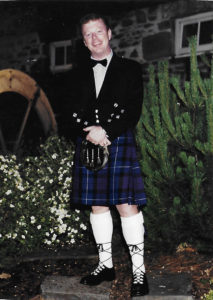 Ted McDonnell in full Chivas Regal attire
Ted McDonnell in full Chivas Regal attire
September 27, 2017
Robert Lehrman, Attorney
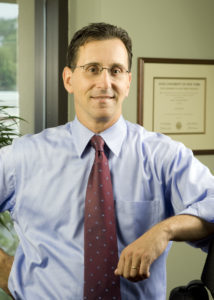 Robert C. Lehrman is a lawyer at Lehrman Beverage Law, PLLC in metro Washington, DC. Since 1988 he has specialized in the federal law surrounding beer, wine and spirits, such as TTB permits, labels, and formulas.
Robert C. Lehrman is a lawyer at Lehrman Beverage Law, PLLC in metro Washington, DC. Since 1988 he has specialized in the federal law surrounding beer, wine and spirits, such as TTB permits, labels, and formulas.
He has helped hundreds of companies formulate beverages to ensure that they are taxed and labeled in an advantageous manner while in compliance with relevant laws and regulations. These companies produce beverages in dozens of countries around the world and range from the largest to the smallest in the beverage industry.
Robert has efficiently reviewed thousands of food and beverage labels over the years. He has also helped to design the labels and get them promptly approved.
When a client calls about a new product they would like to launch, among the first things I tell them is to contact Robert. Neither of us can recall under what circumstances we met, but have some interesting “war stories” about collaborative efforts.
So, I thought it might be fun and informative to interview Robert and for you to learn more about him and his practice.
BB: You are considered among the leading experts in federal regulatory law for alcohol beverages (wine, spirits, and beer). How did you get into this area of specialization?
RL: I stumbled in, like a graduate student into a college bar. I am glad I did. To be honest, it was not a good fit for me in the early years, and I was not wild about the job. It involved a lot of digging through old, tissue-paper pages of dusty old rules, in the CCH Liquor Control Law Reporter. But as I spent more time at it, and got more autonomy, I could change the shape of the job a bit. I think the job changed more than I did. The dusty old pages morphed into up-to-date computer screens. I feel lucky to have been there as law turned from its old, paper ways, toward email and the web.
Anyway, I graduated from law school in Buffalo in the late 1980s. I looked around in DC and the first job offer was from the leading alcohol beverage law firm of the time, Buchman & O’Brien. On that we have something in common because the second of those named partners made his name as general counsel, at a young age, for the leading spirits company of the 20th century — Seagram.
I stayed at Buchman and toiled away in the DC office for a total of about 13 years. At the dawn of the Blackberry age, I decided to embrace the new possibilities and work from anywhere. I started my own little firm in the suburbs, with only a couple of clients. But it really does seem like we have added at least a few clients every week, since that point almost 16 years ago now.
So, getting back to your question, it’s largely happenstance that put me in this position. The internet helped a lot. The rise of small producers helped. Heck, even Arthur Shapiro helped. I am not sure I would enjoy being, for example, a contracts lawyer in a big firm. But, in my current role, what I enjoy most is being at the intersections of law, business, food, branding, and technology. If there is another job that so beautifully blends all these things I like, I can’t think of it.
BB: What are some of the more noteworthy accomplishments you’ve had over the years?
RL: I think the work we did on behalf of absinthe is interesting. It’s a long story so you can find all the details . The short version is that I worked on absinthe legalization, from 2004-2007, when everyone thought it was impossible. We got the law changed after a 100-year ban. It taught me that there is lots of junk science and junk law out there, and our predecessors didn’t always know better.
Another interesting recollection is about an older man who wanted to put the American flag on his beer cans. Not only that, he wanted Iwo Jima, and In God We Trust on the can to complete the patriotic theming. I patiently explained that TTB would not normally allow American flags on beer cans, turns it down regularly, and has at least a few rules directly banning it.
He was unimpressed and showed me another can and asked why our government will allow Russian flags but not the good old American flag. As we encountered various roadblocks, he would intermittently ask if he should go on the Rush Limbaugh program, or send some cash, to get this thing moving. I assured him there was no need to send extra cash, and assumed he was exaggerating, when he threatened to air it out on talk radio. No. A few months later, I picked up the phone and it was Fox News. “Your client is on the way into the studio and we want to verify a few things about his beer label.” A few hours later, TTB called to say the label is approved, flags and all. I would have liked to believe it was dazzling legal skills but in truth, it was good teamwork with a good client. I was sort of hoping he would go on to make a lot of money with this beer, but in short order Budweiser took the idea and ran with it, and I did not see too much action on my client’s product.
BB : Thinking about the label and formula approval process—both at the TTB and the predecessor ATF— in what ways has the process changed over the years? What’s gotten better and what still could use some improvement?
The main changes are that everything has moved from a paper-based to an internet-based system. When I started, in the late 1980s, I would actually walk over to TTB/ATF’s offices, at least five times a week, and talk directly with the decision-makers/reviewers, at their desk. It was a great way to learn. If they said no, they explained why, on the spot.
The old system was a bonanza for Beltway types. It didn’t make sense to mail the labels to Washington. It took a long time, and the government was quite picky in those days. So, you would be just as likely to get a sheaf of rejections, a month after sending your papers to DC, as approvals. And, the rejections might be as trivial and maddening as, there is a comma missing, or one letter is too small. On the other hand, if you sent the labels to a DC law firm, it could be expensive.
The internet gradually changed all that. The processing times were pretty quick, during that old-fashioned setup. You would show up, wait your turn, meet with the reviewer, and walk out with some label approvals, on the same day. Then, as COLAs Online (Certificate of Label Approval) rolled out, things got very slow for many years. Things are good right now. TTB has eased up on the trivialities and is processing most labels quite rapidly.
Another big change is that the system is quite a bit less personal than it used to be. In the olden days, you might sit with a Pamela Jamieson and go over some labels. These days, the rejections are fairly anonymous, you rarely meet with the reviewer, and even if you go in to TTB’s offices, there are many who work from remote locations.
BB: You’ve been front and center in the craft distillers movement. How is this burgeoning business changing? Is it here to stay? Are the entrepreneurs entering the business better equipped to succeed than in the past?
I am a little embarrassed to say, the craft boom was happening all around me, but I did not really notice it. Maybe I was too busy working.
When I started, I suppose there were several dozen busy distilleries in the US and now there are thousands. I remember when Sam Adams was a scrappy little upstart. It may be a lame comparison, but let me try comparing it to the iPhone phenomenon. First you saw it and wondered if it was overhyped, and whether the phenomenon would persist. Cut to ten years later and you can’t really imagine life without it, and it seems firmly entrenched almost to the point where it should have been obvious from day one.
Just like I think the free-for-all among Android, Apple and others is leading to an embarrassment of riches, for consumers, I do think the craft movement is having a similar effect in the libations space. All the fervor and ferment will lead to lots of great new ideas, and even the big stodgy companies to get on their toes, all to the benefit of consumers. It is certainly good for glass companies and liquor lawyers.
Are the barriers to entry too high? Well, they are certainly there, and alcohol beverages remain encrusted in old and new, important and dubious rules. Recent history shows that thousands of scrappy young companies have been able to form and thrive amidst all the barriers and competition.
BB: Finally, it seems to me that your practice has grown over the years in terms of people and expertise. What areas of legal advice/needs do you handle today that you didn’t in the past?
This is true. We are moving up the food chain so to speak. In my early years, I handled mostly labels and formulas, because that’s what I was handling at Buchman. Other lawyers handled things like trademark, for example. We did not really set out to diversify. My first 10 years on my own, confirmed that I could stay busy even within a fairly narrow niche (just federal, just TTB, just alcohol beverages).
But as time passed, I met talented lawyers and their skills drove the diversification. I met Dan (Daniel J. Christopherson), about five years ago and he adds IP law and beer law to our skill set. Lindsey (Lindsey A. Zahn) had a strong interest in appellation law, and wine law nuances, and later developed her skills as an FDA lawyer. Mike (Michael E. Volz) came along and wanted to see what he could do with retail law in the mid-Atlantic states.
At this point, I am pleased to say that we can handle most federal issues that arise for alcohol beverage companies. While we can handle all this in-house, we still reach out to other experts, to supplement our capabilities. In the past, we have reached out to EPA experts (pesticides) and former TTB experts. Just last week I collaborated with one of the top lawyers in the cannabis space, related to CBD-infused spirits. We have federal well covered, for beer, wine and spirits. We also have good coverage in NY, DC, Colorado, Virginia and Maryland. For the other states, we like working with in-state experts.
My goal is to provide excellent service to alcohol beverage companies; I am much less interested in getting bigger, especially if we can keep getting better without adding more people.
~~~~~~~~~~~~~~~~~~
There are a number of outstanding law firms that specialize in alcohol in general and government approvals in particular. Abelman Frayne & Schwab, for example, is a leading full-service firm who I’ve used in a number of areas including intellectual property matters. They do outstanding work. But, Robert Lehrman’s expertise in the approval process leads me to often say, “Better Call Robert.”
September 5, 2017
Dorothy Parker, Gin, and the Center Bar
Allow me to set the stage for you.
Dorothy Parker (1893-1967) was a writer (short stories, poetry, screenplays), one of the founders of the Algonquin Round Table, and a wisecracking, witty critic of 20th-century idiosyncrasies. Dorothy Parker’s quirky remarks and crass opinions were her hallmark. Here are two samples:
“I like to have a martini,
Two at the very most.
After three I’m under the table,
after four I’m under my host.”
The other player is the gin by the same name—Dorothy Parker Gin, produced by New York Distilling Co., an outstanding craft distiller in Brooklyn. (I will write more about NYDC specifically, in an upcoming post. For now, suffice to say that these folks make outstanding gins and rye whiskies. You can find them here.)
Last but by no means least, there is Center Bar, an elegant restaurant, wine bar, and cocktail lounge located on the 4th floor of the Time Warner Center. Under the direction of Chef Michael Lomonaco, whose neighboring Porter House Bar and Grill has established itself as one of the city’s leading modern steakhouses. Porter House is far and away my favorite NYC restaurant and arguably the best steak house in town. Drinks at Center Bar and dinner 50 paces away at Porter House—well, in my opinion, it doesn’t get better than that.
By the way, Porter House was judged to be the Absolute Best Steakhouse in New York and Michael Lomonaco’s creativity is an important element in the story.
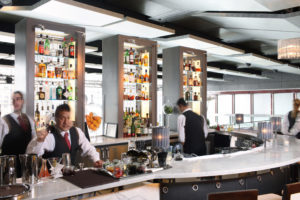 The Center Bar
The Center Bar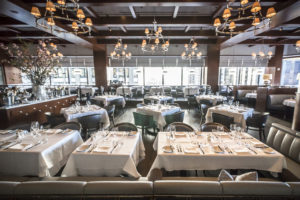 Porter House Bar and Grill
Porter House Bar and Grill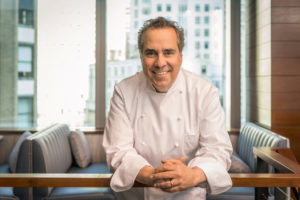 Michael Lomonaco
Michael LomonacoHere’s to Dorothy
August 22nd is Dorothy Parker’s birthday. So, in 2015, Allen Katz, one of the founders of NYDC and Michael Lomonaco, chef and partner at Porter House and Center Bar decided to pay tribute to her and create drinks and a fun experience in her honor. They’ve been running the event every year since.
This year they lined up some of the foremost bar chefs and mixologist and had them create a “Here’s to Dorothy” drink menu. The cocktails were spectacular from the name to the ingredients to the luscious taste.
Be sure to look for the event next year. I’m told Michael has something special planned.
Oh, and if you stop by Porter House, try the Wagyu New York Strip Steak. Unbelievable.
Here are the drinks and their creators:
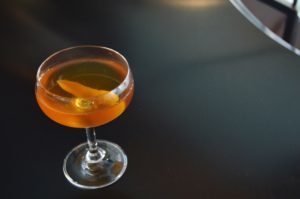 Honey, I’m under the Host
Honey, I’m under the HostJena Ellenwood, The Sparrow Tavern
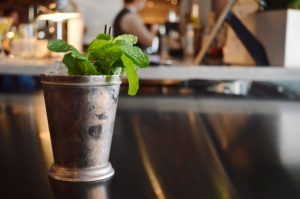 A Walk in the Parker
A Walk in the ParkerLucinda Sterling, Middle Branch
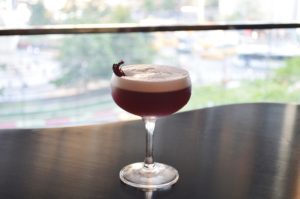 A Certain Lady
A Certain LadyAlissa Atkinson, Precious Metal
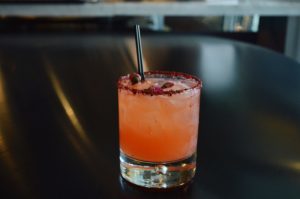 Know-it-all
Know-it-allEstelle Bossy, Del Posto
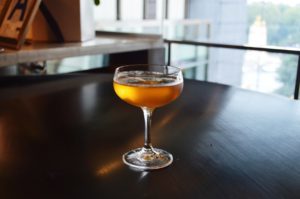 The Mighty Tux
The Mighty TuxTonia Geffy, Highland Park
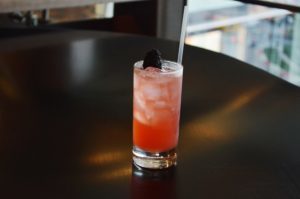 Love Dot
Love DotBrooke Baker, Dead Rabbit
The Menu
August 16, 2017
Word of Mouth Marketing
If you’ve been following this blog (or read my book) you know that, with some exceptions, I’m not a big fan of paid or mass advertising to build brands. In my view, it’s all about point of sale communications, the role of the ‘gatekeeper’ (bar, server, or store people) and consumer conversations.
Call it face-to-face marketing
In fact, there’s a terrific book on the subject called The Face-to-Face Book: Why Real Relationships Rule in a Digital Marketplace. It was written by a longtime friend of mine, Ed Keller and his partner, Brad Fay when they ran the Keller Fay Group. The company is now part of Engagement Labs and Ed Keller is the CEO.
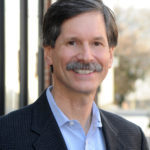 Ed Keller CEO Engagement Labs
Ed Keller CEO Engagement LabsThe Keller Fay Group’s mission was to provide market research and consulting services based on consumer conversations. In 2015, the company merged with Engagement Labs and now offers a “total social” measurement solutions that integrates offline conversation with social media analytics. They bill themselves as “the world’s first TotalSocial® company.” They track, measure, and advise brands on how to understand and apply the insights they gain from consumer conversations.
Here’s a short YouTube video that will explain more.
Word of mouth and alcohol marketing
I’ve long felt that in this marketing environment, the key to a successful brand can be described as follows:
Discovery→ DISCUSSION→ Discernment→ Dissemination
Actually, before talking about this with Ed Keller, I hadn’t paid as much attention to the discussion aspect, when, in fact, consumer conversations can predict sales and marketers need to understand the dynamics. As Ed put it in a recent article on LinkedIn,
“Every brand needs to learn its unique social architecture to realize its full potential, and measuring and modeling is the best way to identify the drivers that will have the most significant impact on sales and other KPIs (Key Performance Indicators).”
Speaking of drivers, Engagement Labs focuses on four key drivers to create a single brand performance score that combine online social media data and offline conversations into their TotalSocial®.
Volume—How much conversation a brand is building both on and offline.
Sentiment—The extent to which that conversation is positive.
Brand Sharing—How much content is being shared.
Influence—In what way are consumer influencers engaged with the brand
In applying this, Engagement Labs ranked leading alcohol brands and learned, as a whole, the alcohol category is made up of so-called whisper brands, which are performing below average both on and offline. When comparing online to offline, these brands perform slightly better offline, in face-to-face conversations.
According to Keller:
“The alcohol beverage industry as a whole is built around a culture of sharing and encourages its customers to engage with others in a social environment—which presents a clear opportunity for brands to engage with its fans and facilitate more meaningful conversations that result in improved sales and brand recognition.”
Think about the winning spirits brands over the years and the role of influencers and consumer conversations in contributing to their success. Brands like Tito’s, Fireball, Rumchata and others. In his Face-to-Face book, Keller tells the story of Blue Moon Beer, served in a branded glass and garnished with an orange, which is in the product ingredients. The question that followed (“Hey, what is that?”) grabbed attention and sparked conversations. And, by the way, rituals related to a brand have always played an important role in their consumer acceptance.
As I write this I’m reminded of Gaz (Gary) Regan’s story of a consumer “expert” and the pains he took to alert his colleagues to his “discoveries” of single malt whiskies. You’ll find the story here, but I’ll save you the trouble:
It seems that when he was bartending in the 1980s on South Street in NYC, a particular Scottish gentleman would come in for lunch every day, order a hamburger and ask for the “book.” It was a guide to single malt scotches and differences in brands, regions, water, grain and distillation styles. After work, the gentleman would meet with friends and colleagues and hold forth on the verities of various malts. While he sounded like an authority on the subject, the information he provided was less than 5 hours old.
Don’t laugh, it helped to build some brands, The Glenlivet included.
About Ed Keller
I have known and worked with Ed when I was in the market research and consulting business at Yankelovich, Roper, and we were partners in our own venture called ASK Associates—all back in the day. So, I can unequivocally say he is among the top marketing research and communications people I know. He’s been a pioneer in word of mouth; a member of the Word of Mouth Marketing Hall of Fame; a past president of the association; and, a prolific writer on the subject. The Engagement Labs company has recently won two awards from the industry.
Whether you’re working on launching a new brand or looking for increased traction for a current brand, you ought to look into the Engagement Labs and their work. In fact, go to their website and download their material.
Tell Ed I sent you.
“Nothing influences people more than a recommendation from a trusted friend,” Mark Zuckerberg once famously said. “A trusted referral is the Holy Grail of advertising.”

July 13, 2017
Well Hung Vineyard
Late last year a man by the name of Peter Marlin contacted me (not his real name for reasons I’ll explain in a moment). He told me he had read and enjoyed my book—already I like him a lot—and wanted my help in marketing a wine brand called Well Hung Vineyard. Now he really had my attention.
Peter has a full-time job as a business advisor, doing quite nicely, but his dream was always to go into the wine business. So, he bought a brand in Virginia, kept it under the radar, and set out to develop it until such time as he was ready to go at it full time.
It didn’t take very long for him to realize that part-time is no time to build a brand in the booze business.
How the Name Came About
As the story goes… There were three women in Virginia, all close friends, and they loved their late afternoon wine sessions. One of them owned a small farm that was just perfect for cultivating grapes and, over time, the vineyard grew and flourished.
One day, as the three ladies were touring this 2-acre vineyard, one of them grabbed hold of a cluster of grapes, laughed, and remarked, “girls, these grapes sure are well hung.” They had a good laugh. But, after a second or two, they looked at each other and had a eureka moment. A visit to a trademark attorney followed and a brand was born.
These grapes were made into wine at a local winery and sold each weekend at farmer’s markets, wine festivals, small retail outlets, and other venues around the state.
Over time, things began to change. One left for personal reasons and the others grew weary of running all over the state each weekend. It was time for them to move on. What began as a hobby—you might say a labor of love—was becoming difficult to manage.
So, reluctantly they began to investigate a sale of the small vineyard and, especially, the brand name.
Peter and His Dream
Eventually, through a friend of a friend—you know how that goes—Peter heard of the opportunity and negotiations began, were discontinued and back on again—you certainly know how that also goes. Finally, he bought the brand.
Peter, like most entrepreneurs, saw an opportunity for this brand to be bigger than it was and perhaps with a national footprint. His strategy was to continue to sell the wine locally, but also bought wine from producers and marketed them under the Well Hung Vineyard label.
From the website:
Founded in 2008 by three women who recognized the value of a good joke and a great glass of wine, Well Hung® Vineyard has a proud heritage and a bright future. Today, Well Hung® Vineyard is all about growth. Working with winegrowers across the country, we are able to source the best fruit to go into our up and coming wines.
An unexpected dividend cropped up. It turns out that the women who created the brand were savvy enough to also register the brand for clothing, nuts, and other items. And, these were and still are selling well.
Where do I Come in?
The call with Peter was candid. He saw great opportunities for his brand (and dream) but faced many obstacles—not least of which was the time and effort to build a brand and get the best wine available. In addition, despite the “I got to try this wine” attitude of consumers, finding distributors was more than just a challenge (see the previous article on LibDib), it was a major obstacle.
Peter wanted to enlist my aid in making his dream come true. As we talked a few things occurred to me.
First, in a cluttered wine market, name and packaging can cut through and quickly gain awareness in stores and on menus. In a world of Barefoot, Cupcake, Layer Cake, Little Black Dress, we also have provocative labels like Bitch, Fat Bastard, Old Fart, and more. The idea is to buy the first time because of the name/label and buy again because of the wine itself. Of the one billion wine gallons sold in the US, most are sold to non-maven and non-aficionado consumers who enjoy wine, the experience, and, yes, the label.
Come on… compared to the lame names cited above, you have to admit that “Well Hung” is amusing, a double entendre, a play on words, and a fun way to offer someone a glass of wine. A smile and a conversation are bound to follow.
Second, while I liked the idea of helping, this was more than I could handle in my consulting practice, even if I knew more than I do about the wine business. So, I needed a partner.
Enter Rob Warren
Rob and I knew each other well at Seagram and also worked together when he was with Diageo and I was an advisor to Jose Cuervo International, which they distributed at the time. We think alike and have lots of mutual respect. Besides, he has a great sense of humor and in between moments of marketing and brand building excellence, we laugh a lot.
It didn’t take Rob and I long to figure out that without money, resources, and the need for much time, building a wine business was more than just an uphill battle. Think Mount Everest. And so, the idea of licensing the name, Well Hung Vineyard, came readily to mind.
Peter was already selling wine from winegrowers around the country and it’s not a big leap to enter into a business arrangement with a company who initially can produce a red, white, and others. Eventually, varietals and vintage could be added to the mix. In the right hands and with the right wines, this brand could be a winner.
The clothing and other items under the WHV brand would only add to the allure.
~~~~~~~~~~~~~~~~~~
That’s where things stand at the moment—a search for a business partner interested in licensing the name. Stay tuned and I’ll let you know how things develop.
Oh, by the way, Peter also owns the trademark that should help with an Australian wine producer. It’s called Well Hung Down Under.
Disclaimer: While Rob is calling the shots, and taking the lead, I’m along for the ride. Hey, who says I can’t also have a dream or two?
June 20, 2017
Liberating the Alcohol Distribution System
The actual name of the company setting out to address the booze business wholesaler problems is Liberation Distribution (known as LibDib). The Founder/CEO is Cheryl Durzy and I spoke to her at length recently and, let me tell you, her business model could very well be a game changer in how beer, wine, and spirits come to market.
 Cheryl has close to 20 years’ experience in the wine industry, managing wholesalers of all sizes, and learned firsthand what a nightmare it is for a small company to get to the shelves of restaurants, bars, and stores. She set out to fix the problem.
Cheryl has close to 20 years’ experience in the wine industry, managing wholesalers of all sizes, and learned firsthand what a nightmare it is for a small company to get to the shelves of restaurants, bars, and stores. She set out to fix the problem.
I’m very impressed with her web-based platform and think it’s a major positive development for producers (she calls them Makers) and restaurants, bars, and retail shops (RB&R). As Cheryl puts it, “Our goal is to make it easier for small businesses (Makers) to do business with other small businesses (RB&R).
But, as you’re about to learn, it’s much more than that. It’s a boon to the producers, the retailers, the consumer, and, even the current wholesalers.
The Problem
First, the background, as I’m sure nearly all of you know.
The three-tier system of alcohol distribution was set up after Prohibition and consists of producers, distributors, and retailers. Producers can only sell to wholesale distributors who, in turn, can only sell to retailers who sell to consumers.
The system favors wholesalers, especially in view of the consolidation of this tier—which has reduced the number significantly and increased their size. At the same time, it favors the large producers, who have the clout to get attention. Both work closely together for obvious mutual benefit. As I’ve written many times before, “follow the money.” The produce-wholesaler business model is based on volume; the distributor sales rep compensation is based on volume as well. If you were a sales person for a large distributor, which would you focus on—a 3 bottle placement of a craft product or a hand truck of a leading selling brand? Let’s be fair; they are in business to make money,
As a result, small and mid-sized wine, beer, and spirits producers have limited distribution and face many obstacles. Often the large distributors will turn them down or worse, take them on and not pay attention.
Oh, and don’t forget the small RB&R operator who also suffers from the focus on bigness. I follow many bartenders and managers on Facebook and Twitter and there are complaints aplenty about delayed shipments around holidays and long weekends when they can’t get their craft products their customers want. As one prominent Food and Beverage manager told me, “my customers come here for boutique brands that are not mainstream … and getting a timely delivery around the holidays is a nightmare.”
According to Cheryl:
Efforts to change distribution laws have been ineffective, however the market is ripe for disruption. Just as the hotel and transportation industries were disrupted by technology, the alcohol distribution market now has a technology platform that is shaking things up with a new option for small to mid-sized Makers.
The LibDib Solution
If you look at what the platform offers both producers and accounts, I think it’s very impressive. So much so that I have suggested to a number of startup clients of mine that they give this serious consideration.
Currently, LibDib is operating in CA and NY (with more markets on the way) and here’s how it works for producers:
A producer enters their information and license online.
Product is stored at a producer’s location including their production facility, personal warehouse or third party warehouse, depending on the producer’s choice.
It’s delivered by a common carrier, also based on producer’s choice.
The charge/fee from LibDib is 15% – 20%, less than what other distributors and wholesalers currently charge.
There are no bill backs, no aging inventory, and no buying back product.
Producers are free to leave LibDib at will; they will not enforce Franchise Laws. This makes them effective as an “incubator.”
They handle the billing, collection, and reporting, which makes them a virtual back office.
A producer can invite any account to purchase their product by sending them a link to the LibDib site. (See this video.)
And, LibDib is developing a team of platform sales people whose role will be to recruit bars, restaurants and retail stores. These folks can ultimately become brokers and sales people for the brands.
The accounts benefit by being able to buy what they want and when they want it. There are no minimums. There is no middleman, since the accounts can communicate directly with producers through the LibDib platform. Sales materials and POS are current and easily downloadable. Best of all, in my view, an account can provide the experience of unique, local and limited available products, with no hassle.
As a consumer, I’m perfectly happy buying Buffalo Trace or Bulleit Bourbon, but often I want a Koval or Dad’s Hat whiskey and can’t get it. It would be nice to suggest to my retailer or favorite drinking hole, that it’s pretty simple for them to stock less mainstream brands.
Other Potential Winners
When I was at Seagram, new products, no matter the potential, were an annoyance. It meant deflection of assets—people, money, and other resources—that could be applied to mainstream brand growth and, making the annual sales plan. That problem still exists, although companies like Diageo and Pernod Ricard have established venture groups to facilitate traction from a new brand or idea. But, at the same time, wholesalers still have to deflect their resources to address a fledgling brand’s needs. Oh sure, there are dedicated craft and startup resources at the distributor level but not all are equally effective at building brands.
It seems to me that LibDib, with its incubator capability, just might be the answer for the big boys. I know that if I were still at Seagram, I’d definitely give it a shot.
Finally, wholesalers themselves can benefit from LibDib. It’s a way to test market a new product before taking it on. It can augment and amplify the efforts of craft divisions and personnel. And, it can lift the negative feelings and imagery surrounding how and why large wholesalers overlook small, startup brands.
Like I said, LibDib has the potential to be a real game changer.
June 5, 2017
You Don’t Have to be Jewish…
For the past five years, Josh Hatton and Jason Johnstone-Yellin have been holding an event involving whisk(e)y tastings, education, and an overall fun evening. On June 15, at Studio 450, they will have their 2017 New York City show. (Other shows are in Chicago and Seattle.)
I’ve been intrigued with this event and set out to learn more about it by contacting Josh and talking to previous attendees and industry insiders.
Let’s start with their simple description from their website:
“The world famous Whisky Jewbilee is a nationwide parade of top-shelf spirits and fine kosher dining for whisky lovers of any faith.
I also learned that the Whisky Jewbilee is considered one of “the world’s top 10 whisky shows,” by The Spirits Business.”
Many of the people I spoke with told me previous shows have had huge turnouts and they consider the event to be top notch.
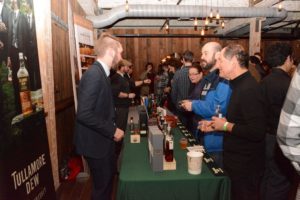 The Organizers
The OrganizersThe Whisky Jewbilee is one of three businesses owned by the Jewish Whisky Company LLC, an umbrella organization that also owns two other companies—Whisky Geek Tours of Scotland and Single Cask Nation. The latter is an independent bottler that describes itself as follows:
Single Cask Nation began as a social fellowship or membership society organized around the right to purchase rare, fine single cask whiskies under the Single Cask Nation label. More than a mere club, Single Cask Nation represents a unique virtual community in which members share a common affinity for the quality whiskies and other spirits of the world.
The idea is as old as scotch whisky itself. Johnnie Walker, Chivas Brothers and many others began as purveyors selling whisky from various distillers. Single Cask Nation has some interesting offerings. You might want to check it out.
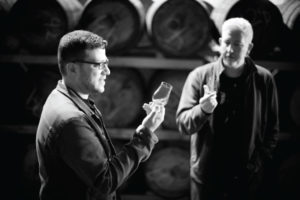 Josh Hatton (L) and Jason Johnstone-Yellin (R)
Josh Hatton (L) and Jason Johnstone-Yellin (R)The event—Jews and Booze
You might not realize it or never thought about the fact that members of the Jewish faith love whisk(e)y. A June 2013 NY times article, had this to say:
“Whiskey has numerous fan bases, but few are more devoted — and arguably less noticed by the press and public — than Jews, particularly observant Jews. Synagogues are increasingly organizing events around whiskey, and whiskey makers are reaching out to the Jewish market.”
In fact, many religious Jews wanted to attend Whisky Fest but could not because it’s held on Friday and Saturday nights. So, Whisky Jewbilee was launched in 2012 (on a Thursday night) with the blessing of the Whisky Fest people. It grew significantly over the years.
Today, the event will cap at 450 attendees and 80 companies/brands will be present with roughly 300 whisk(e)y SKUs (individual brands). But check this out—this is not a drinking event as much as it is a knowledge event and a one to one dialogue between producer and consumer. You won’t find beautiful people from central casting behind the tables or actors mindlessly spewing memorized lines. What you will find are whisky aficionados and well-informed representatives of the distilleries.
By the way, many marketers have told me that kosher consumers are very brand loyal. Perhaps more so than many other market segments.
About that Kosher thing…
I’m far from an expert on Judaica matters but I couldn’t help but wonder about what possibly could be in whisk(e)y that would violate the rules of kosher. So, I spoke with Josh about it and did some research.
What I learned is that there is nothing in whisk(e)y to make it non-kosher. Wine on the other hand, because of its sacramental use, has strict kosher rules. But with a few minor exceptions, nearly all whiskies are okay.
The organizers welcome all whiskies regardless of maturation style. This means that whiskies matured in sherry, port or other wine based casks are perfectly fine and will be present at Whisky Jewbilee. They believe all whisk(e)y to be kosher-by-nature unless the whisk(e)y is flavored. At their event, only the food is under kosher supervision.
The flavored whisky situation has to do with the fact that the flavorings used to augment the whiskey taste might contain non-kosher elements like glycerin. It would take certification to assure observant Jews that the glycerin is a vegetable rather than animal based oil.
But you will find some amazing whiskies there including some of my favorites from Brenne Whisky, Koval Distillery, FEW Spirits, and the best in the world, including—Bowmore, Glen Grant, Four Roses, Michter’s, High West, and many more.
~~~~~~~~~~~~~~~~~~
The organizers of the event have invited me to be there and part 2 of this article will be after June 15. If you attend, please look for me and say hi.
The Chicago Whisky Jewbilee will be on November 9 at Artifact Events. The Seattle show will be some time in February or March.
And, remember, you don’t have to be Jewish to attend. Just enjoy!

